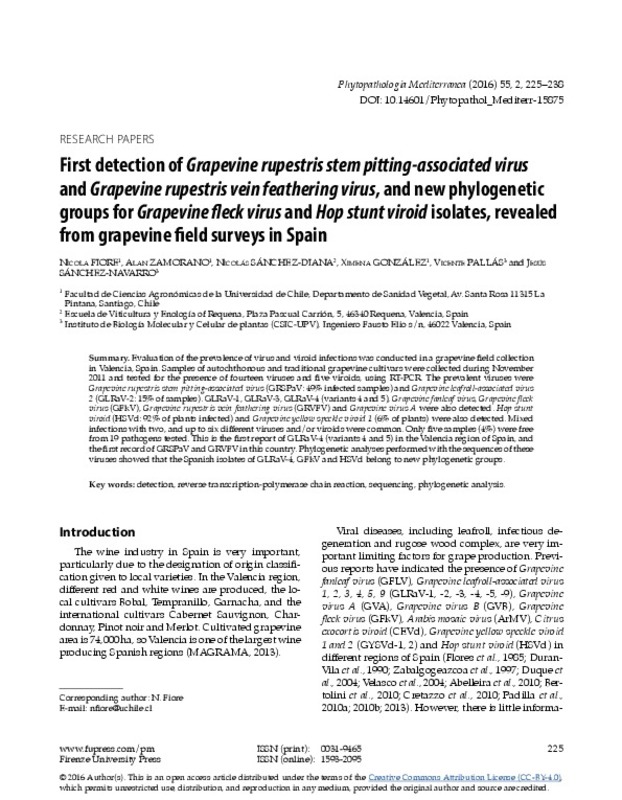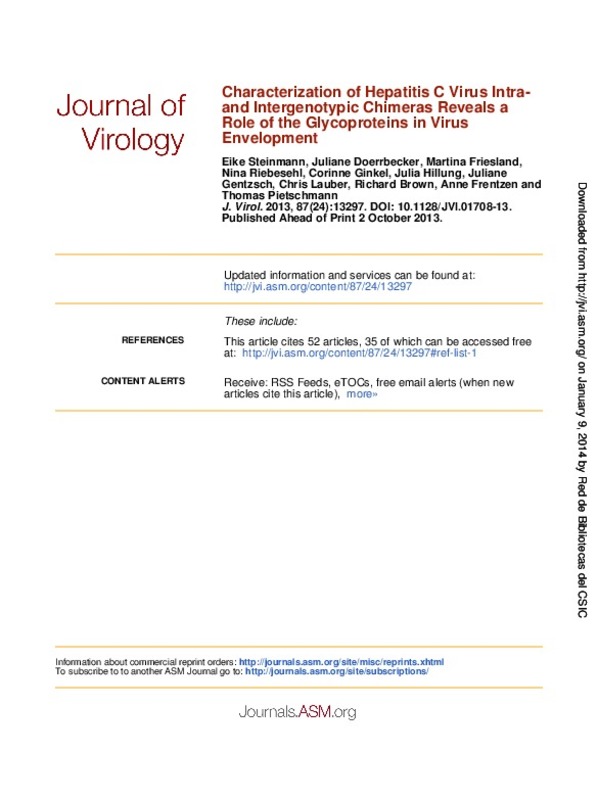|
Resumen:
|
[ES] El virus del mosaico amarillo del calabacín (ZYMV) causa enormes pérdidas en cucurbitáceas de todo el mundo, por lo que es esencial conocer cómo se mueve por la planta huésped. Se dispone de un clon infeccioso etiquetado ...[+]
[ES] El virus del mosaico amarillo del calabacín (ZYMV) causa enormes pérdidas en cucurbitáceas de todo el mundo, por lo que es esencial conocer cómo se mueve por la planta huésped. Se dispone de un clon infeccioso etiquetado con el gen reportero Rosea1 (ZYMV-Ros1), que permite seguir la infección a simple vista. El virus se replica eficientemente en Nicotiana benthamiana, pero se mueve a larga distancia de forma subóptima. Por esto, debe haber factores en las cucurbitáceas que medien el movimiento a larga distancia del virus, constituyendo este clon un buen sistema experimental para estudiar cuales son esos factores. Trabajos previos apuntan a que los factores del huésped eIF4E y eIF(iso)4E podrían mediar en el movimiento a larga distancia. Para contrastar esta hipótesis, se pretende suplementar el clon ZYMV-Ros1 con otros factores eIF4E y eIF(iso)4E, tanto de huéspedes naturales del ZYMV como de otras plantas, en Nicotiana, para analizar su efecto sobre el movimiento sistémico del virus.
[-]
[EN] Zucchini yellow mosaic virus (ZYMV) is a RNA virus belonging to genus Potyvirus. This virus particularly affects cucurbitaceous plants and induces huge losses worldwide. This work has been aimed to understand how ZYMV ...[+]
[EN] Zucchini yellow mosaic virus (ZYMV) is a RNA virus belonging to genus Potyvirus. This virus particularly affects cucurbitaceous plants and induces huge losses worldwide. This work has been aimed to understand how ZYMV moves throughout the host plants. A ZYMV infectious clone tagged with the report gene Rosea1 (ZYMV-Ros1) was available. This virus induces anthocyanin production and red pigments accumulation, allowing the tracking by the naked eye of infection dynamics in the whole plant. The infectious clone efficiently replicates in Nicotiana benthamiana and induces anthocyanin synthesis in the inoculated tissue. However, the ZYMV-Ros1 clone moves suboptimally through the plant and a few numbers of red spots are detected in some systemic leaves, what means that, somehow, some viral particles have entered in the phloem and have reached systemic tissues. For this reason, some factor or factors from cucurbitaceous plants that are not present in N. benthamiana should mediate in the long-distance movement of this virus. The infectious clone ZYMV-Ros1 provides an extraordinary experimental system to study which are these factors, since the virus allows following the infection by the naked eye. Previous researchers have suggested that the translation initiation factors 4E (eIF4E), from host plants, or its isoforms eIF(iso)4E could mediate in the long-distance movement of potyviruses throughout the host plants. With the aim of testing this hypothesis, the eIF4E and eIF(iso)4E factors from zucchini (Cucurbita pepo) and melon (Cucumis melo), host plants in which the ZYMV moves efficiently, from N. benthamiana, where the virus moves suboptimally, and from N. tabacum cv. Xanthi nc, where the virus does not move, were cloned. The translation factors were cloned in an expression plasmid that allows their expression in N. benthamiana and were coexpresed together with the infectious clone ZYMV-Ros1. The effect that the coexpression had on the systemic infection in N. benthamiana was analyzed. The results showed that coexpression of two eIF4E alleles from zucchini and the eIF(iso)4E from N. tabacum cv. Xanthi nc improved the ZYMV systemic movement, supporting the hypothesis that this factor is involved in the long distance movement of virus. Besides this, the eIF4E from zucchini and the eIF(iso)4E from N. tabacum cv. Xanthi nc were cloned in the infectious clone ZYMV-Ros1 to study the effect of these proteins on viral movement when they are expressed from the virus polyprotein. In this case the results showed that translation factors hampered the
viral movement. The conclusion of this work is that translation initiation factors of the host appear to be involved in the long distance movement of ZYMV, but they alone are not sufficient to mediate this movement. Other host factors must be also involved in the process.
[-]
[CA] El virus del mosaic groc de la carabasseta (ZYMV) és un virus d'ARN pertanyent al gènere Potyvirus. Este virus afecta sobretot a cultius de cucurbitàcies, provocant importants pèrdudes en tot el món. En aquest treball ...[+]
[CA] El virus del mosaic groc de la carabasseta (ZYMV) és un virus d'ARN pertanyent al gènere Potyvirus. Este virus afecta sobretot a cultius de cucurbitàcies, provocant importants pèrdudes en tot el món. En aquest treball es tractà d’entendre com el ZYMV es mou per la planta hoste. Es disposava d'un clon infecciós del ZYMV etiquetat amb el gen reporter Rosea1 (ZYMV- Ros1), el qual induïx la biosíntesi d'antocianines, pigments rojos que permeten seguir la infecció viral a simple vista. Este virus es replica molt eficientment en Nicotiana benthamiana i induïx la producció d'antocianines en el teixit inoculat. No obstant això, es mou a llarga distància de forma subòptima i en fulles distals només s'observen unes poques taques roges induïdes per unes poques partícules virals que, d'alguna manera, aconseguixen entrar en el floema i arribar a teixit sistèmic. Per açò ha d'haver algun factor o factors en les cucurbitàcies, i no en N. benthamiana, que medien el moviment a llarga distància d'este virus. Gracies a la possibilitat de seguir visualment la infecció, el clon infecciós ZYMV-Ros1 constitueix un sistema experimental amb un potencial enorme per a estudiar quins són estos factors. Diversos treballs, prèviament publicats, han sugerit que els factors d’inici de la traducció 4E (eIF4E) de l’hoste o les seues isoformes eIF(iso)4E podrien mediar en el moviment a llarga distància dels potyvirus. A fi de contrastar esta hipòtesi, es van clonar els eIF4E i eIF(iso)4E de carabasseta (Cucurbita pepo) i meló (Cucumis melo), hostes en els quals el ZYMV es mou eficientment, de N. benthamiana, en que el virus es mou subòptimament, i N. tabacum cv. Xanthi nc on el virus no es mou. Els factors de traducció es clonaren en un plàsmid que permetia la seua expressió transitòria en N.benthamiana i es van coexpresar junt el clon infecciós ZYMV-Ros1. Es va analitzar l'efecte d'esta coexpresió en l'aparició de focus d'infecció sistèmics en N. benthamiana. Els resultats mostraren que la coexpresió de dos al·lels de l’eIF4E de carabasseta i l’eIF(iso)4E de N. tabacum cv. Xanthi nc afavorixen el moviment sistèmic del ZYMV, recolzant la hipòtesi de que este factor està implicat en el moviment a llarga distància del virus. Per altra banda, es van clonar l’eIF4E de carabasseta i l'eIF(iso)4E de N. tabacum cv. Xanthi nc en el clon infecciós ZYMV-Ros1, per a estudiar l'efecte d'estes proteïnes sobre el moviment viral quan s'expressen des de la mateixa poliproteina del virus. En este cas els resultats
estas proteínas sobre el movimiento viral cuando se expresan desde la misma poliproteína del virus. En este caso los resultados mostraron que los factores de traducción entorpecían el movimiento viral. La conclusión de este trabajo es que los factores de inicio de traducción del huésped parecen estar implicados en el movimiento a larga distancia del ZYMV pero no son suficientes para mediarlo. Otros factores del huésped deben estar también implicados en el proceso.
mostraren que els factors de traducció entorpien el moviment viral. La conclusió d'este treball és que els factors d'inici de la traducció de l'hoste pareixen estar implicats en el moviment a llarga distància del ZYMV, però no són suficients per a mediar este procés. Altres factors de l'hoste han d'estar també implicats en el moviment sistémic del virus.
[-]
|










